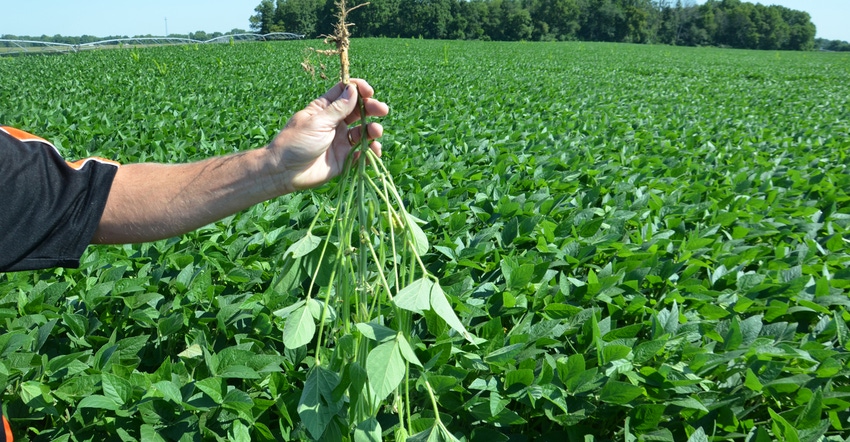
This story must start with a disclaimer. The majority of soybeans plants in the Soybean Watch ’20 field aren’t dealing with soil compaction issues. But in the field, as in almost any field, Steve Gauck says you can find at least some plants impacted by soil compaction.
“It’s often sidewall compaction from the planting trench when the planter goes through a spot that was maybe on the heavy side,” says Gauck, regional agronomy manager for Beck’s, based near Greensburg, Ind. Beck’s sponsors Soybean Watch ’20.
These soybeans were no-tilled into heavy cornstalk residue on June 6. The field is located in an area with rainfall patterns somewhat like 2019 in early spring, although not as severe.
“If you look hard enough, you will find some plants affected by soil compaction,” he says. In conventionally tilled fields that were worked on the heavy side, you may find lots of plants that battle through a shallow soil compaction layer. You can also find plants in some fields whose roots encounter either shallow or deeper soil compaction created during previous seasons.
Gauck pulled up a few plants to make a point during a late-summer visit to the Soybean Watch ’20 field. One plant had a 90-degree crook 3 or 4 inches below the soil line (see main photo above). When held upside down, it looked like an optical illusion, with the roots offset on one side of Gauck’s hand.
“The roots obviously hit a hard layer, but worked through it, then went on down,” he says. “The most obvious observation was that roots were full of active nodules, and although it may have had to work to get a start, the plant branched and was full of nodes and pods. It was on its way to being very productive, despite dealing with soil compaction early.”

HEALTHY PLANTS: The soybean plant on the left has flatter roots, indicating they dealt with sidewall soil compaction. But both are healthy, productive plants.

Gauck found two other plants, shown in the photo above. Roots on the plant on the left are flatter compared to roots of the plant on the right. They arc down in a normal fashion.
“The plant with flatter roots near the surface probably battled some shallow compaction issue,” Gauck says.
“The most striking thing, though, is that again, both had root systems covered with nodules,” he notes. “And both were healthy, productive plants. Both were in the transition from R3 to R4, which are pod set stages, but both looked like they would turn out to be healthy, productive plants.”
So, is soil compaction a nonissue for soybeans? Gauck isn’t ready to go that far. What he can say is that observation indicates soybean plants fight through soil compaction situations, perhaps experiencing less impact than corn plants. It’s the same conclusion university researchers who have studied soil compaction for decades have made.
“Don’t count these plants out for contributing to yield just because they encountered soil compaction,” Gauck says. “Given adequate soil moisture and proper nutrition, they can compensate and produce well.”
About the Author(s)
You May Also Like




